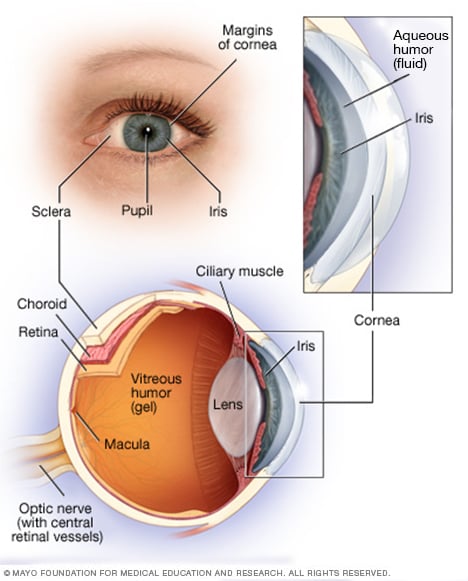Color blindness
Color blindness
overview
Anatomy of the eye

Anatomy of the eye
Your eye is a complex and compact structure about 2.5 cm in diameter. It receives millions of pieces of information about the outside world, which are quickly processed by your brain.
Color blindness – or more specifically, poor or deficient color vision – is the inability to see the difference between certain colors. Although many people often use the term “colorblind” to describe this condition, true colorblindness—where everything is seen in shades of black and white—is rare.
Color blindness is usually inherited. Men are more likely to be born with color blindness. Most people with color blindness cannot distinguish between certain shades of red and green. More rarely, people with color blindness cannot distinguish between shades of blue and yellow.
Certain eye diseases and some medications can also cause color blindness.
Symptoms
You may have color vision deficiency and not know it. Some people find that they or their child have the condition when it causes confusion - for example, when they have trouble distinguishing the colors of a traffic light or interpreting color-coded learning materials.
People affected by color blindness may not be able to distinguish:
- Verschiedene Rot- und Grüntöne
- Verschiedene Blau- und Gelbtöne
- Beliebige Farben
The most common color deficiency is the inability to see some reds and greens. Often a person with red-green or blue-yellow deficiency is not completely insensitive to both colors. Defects can be mild, moderate or severe.
When to go to the doctor?
If you suspect you are having trouble distinguishing certain colors or your color perception changes, see an eye doctor to have it tested. It is important that children receive comprehensive eye exams, including color vision tests, before starting school.
There is no cure for congenital color deficiencies, but if an illness or eye disease is the cause, treatment can improve color vision.
Causes
Seeing colors across the light spectrum is a complex process that begins with your eyes' ability to respond to different wavelengths of light.
Light containing all color wavelengths enters your eye through the cornea and travels through the lens and the transparent, gelatinous tissue in your eye (vitreous humor) to wavelength-sensitive cells (cones) at the back of your eye in the area of the macula and the retina. The cones are sensitive to short (blue), medium (green) or long (red) wavelengths of light. Chemicals in the cones trigger a reaction, sending the wavelength information to your brain through your optic nerve.
If your eyes are normal, you perceive color. However, if your cones lack one or more wavelength-sensitive chemicals, they won't be able to distinguish the colors red, green, or blue.
Color blindness has several causes:
-
Inherited disorder.Inherited color deficiencies are much more common in men than in women. The most common color deficiency is red-green, while blue-yellow deficiency is much less common. It is rare to have no color vision at all.
You may inherit a mild, moderate or severe degree of the disorder. Inherited color deficiencies usually affect both eyes, and the severity does not change throughout your life.
- Krankheiten. Einige Bedingungen, die Farbdefizite verursachen können, sind Sichelzellenanämie, Diabetes, Makuladegeneration, Alzheimer-Krankheit, Multiple Sklerose, Glaukom, Parkinson-Krankheit, chronischer Alkoholismus und Leukämie. Ein Auge kann stärker betroffen sein als das andere, und das Farbdefizit kann besser werden, wenn die zugrunde liegende Krankheit behandelt werden kann.
- Bestimmte Medikamente. Einige Medikamente können das Farbsehen verändern, wie z. B. einige Medikamente, die bestimmte Autoimmunerkrankungen, Herzprobleme, Bluthochdruck, erektile Dysfunktion, Infektionen, Nervenstörungen und psychische Probleme behandeln.
- Altern. Ihre Fähigkeit, Farben zu sehen, lässt mit zunehmendem Alter langsam nach.
- Chemikalien. Der Kontakt mit einigen Chemikalien am Arbeitsplatz, wie z. B. Schwefelkohlenstoff und Düngemitteln, kann zu einem Verlust des Farbsehens führen.
Sources:
- Was ist Farbenblindheit? Amerikanische Akademie für Augenheilkunde. https://www.aao.org/eye-health/diseases/what-is-color-blindness. Abgerufen am 26. September 2019.
- Kliegman RM, et al. Untersuchung des Auges. In: Nelson Lehrbuch der Kinderheilkunde. 21. Aufl. Elsevier; 2020. https://www.clinicalkey.com. Abgerufen am 26. September 2019.
- Fakten über Farbenblindheit. Nationales Augeninstitut. https://nei.nih.gov/health/color_blindness/facts_about. Abgerufen am 26. September 2019.
- Bennett CR, et al. Die Beurteilung der Sehfunktion und des funktionellen Sehens. Seminare in Kinderneurologie. 2019; doi:10.1016/j.spen.2019.05.006. Abgerufen am 26. September 2019.
- Yanoff M. et al., Hrsg. Molekulargenetik ausgewählter Augenerkrankungen. In: Augenheilkunde. 5. Aufl. Elsevier; 2019. https://www.clinicalkey.com. Abgerufen am 26. September 2019.
- Hassall MM, et al. Gentherapie für Farbenblindheit. Yale Journal für Biologie und Medizin. 2017;90:543.
- Farbsehschwäche (Farbenblindheit). Nationaler Gesundheitsservice. https://www.nhs.uk/conditions/colour-vision-deficiency/. Abgerufen am 1. Oktober 2019.

 Suche
Suche
 Mein Konto
Mein Konto